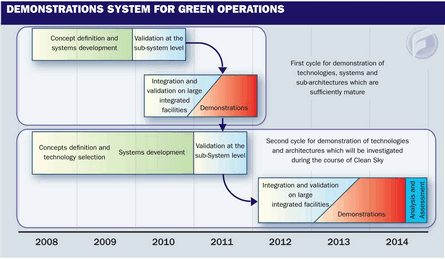Systems for Green Operations (SGO) is one of Clean Sky's six Integrated Technology Demonstrator programmes that concentrate on two key areas: management of aircraft energy, led by Liebherr and mission and trajectory management, led by Thales. SGO's budget of €306 million ($479 million) will be funded equally between the European Commission and industry. The six other members involved in SGO - Airbus, Alenia Aeronautica, Fraunhofer, Rolls-Royce, Saab and Safran - will apply their capabilities, where applicable, to the aircraft energy and/or mission and trajectory areas.
As well as the main members, programme "associates" will be involved. These include Diehl Aerospace, EADS, the German DLR research institute, GSAF (a cluster of the Dutch research centre NLR, universities and small to medium-sized enterprises), Selex Galileo, the University of Nottingham in the UK and Zodiac. A call for proposals will shortly be issued to garner additional partners, for which the 25% of the overall funding is earmarked.
Energy Management
MAE encompasses all aspects of on-board energy provision, storage, distribution and consumption. Sébastien Dubois, Clean Sky programme manager for Thales, says the optimisation of power consumption as well as of the aircraft energy along the mission will be accomplished by reducing waste energy directly attributable to aircraft systems through better equipment system efficiency and optimisation of energy transport and distribution systems. This will directly reduce fuel consumption and hence exhaust CO2 and NOx.
"We will invent and design the new generation of electrical on-board systems to achieve an 'all-electric' aircraft," says Dubois. "The idea being that electrical systems have a better individual efficiency leading to a superior overall efficiency at the 'aircraft level' than would a mixture of pneumatic, hydraulic and electrical hybrid systems."
The principal activity focus of Clean Sky and especially the SGO programme will be the validation and maturation of technologies and sub-architectures to the NASA-coined yardstick, "technology readiness level" 6. For the purposes of Clean Sky, TRL 6 requires that technologies tested will be mature enough to be incorporated into prototype subsystems.
"We need to have mature solutions at the end of the Clean Sky programme. Reaching TRL 6 will enable us to use the solutions on the new-generation aircraft we expect to be launched at the end of Clean Sky," says Dubois.
 |
|---|
The SGO demonstrations will cover ground-based architectural integration of electrical generation, distribution and loads, together with their management ground-based architectural integration of thermal management technologies flight-proven electrical equipment systems, including environmental conditioning, actuation, and ice protection flight-proven technologies, architectures and concepts for distribution and recycling of electrical energy through power electronics flight-proven technologies and subsystems for thermal exchange and management, including liquid loops and large heat exchangers and flight testing of mature thermal and electrical technologies to demonstrate aspects of total energy management.
Mission And Trajectory
The overall goal for MTM is to realise a green mission from start to finish, with the management of climb, cruise and descent profiles based on a new aircraft performance database. These trajectories and functions, which will be hosted in the flight management system, will allow the aircraft to fly an optimum route with the lowest noise, emissions, fuel consumption, and with real-time awareness of atmospheric conditions. These objectives will be validated via in-flight demonstrations and ground-based demonstrations using cockpit simulation.
"This part deals with how we fly the aircraft so that it fulfils a given mission - flying from A to B - and with 'intelligent' mission profiles and trajectories, while reducing fuel consumption and noise impact, especially in the phases close to the ground," says Dubois.
"Smart ground operations" will use new systems solutions and new ground procedures to reduce fuel consumption and offer additional environmental benefits. "We know that using engines optimised for the flight are not efficient for moving the aircraft on the ground, so the idea is to investigate new solutions such as motorised landing gears for a better overall efficiency and 'silent' taxiing," he adds.
Building on Research
Dubois points out that SGO will capitalise on the results of previous and ongoing European studies. "We have already achieved TRL 3-4 for some technologies investigated in previous projects," he says, "and we will use Clean Sky's Joint Technology Initiative approach to take what we have already matured, and subsequently validate it using full-scale ground demonstrators, and then possibly with flight demonstrators by the end of 2011."
Efforts will be made to ensure harmonisation with the Single European Sky ATM Research (SESAR) programme, in which Thales also plays a leading role. While SGO will take into account SESAR in terms of procedures and ATM constraints, its scope will be limited to on-board systems optimisation for environmental impact at the aircraft level only.
Source: Flight International























